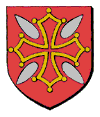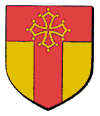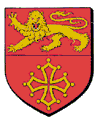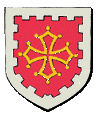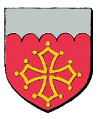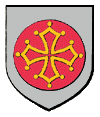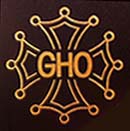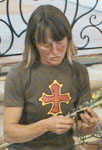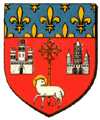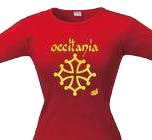
![]()
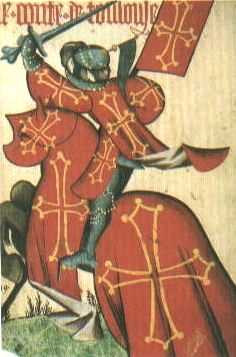
![]() This device was the coat of arms of the family of St-Gilles,
Counts of Toulouse in the Middle Ages.
This device was the coat of arms of the family of St-Gilles,
Counts of Toulouse in the Middle Ages.
Wherever you go in the Languedoc, you will notice the Cross of Toulouse. You will find it incorporated into official arms of local government bodies, embroidered on flags, carved in stone, wrought in iron, printed on postcards, displayed in stained glass. You will find it worn as jewellery, sold as souvenirs to tourists, scrawled on walls as graffiti. You will even find it set in brass in the ground in public squares and visible in patterns of red and gold flowers.
Heraldry of the Cross of Toulouse
The "Occitan Cross"
The "Cathar Cross"
The significance of the Cross of Toulouse.
Examples of the cross of Toulouse.
Heraldry of the Cross of Toulouse
|
|
|
One medieval roll blazons the arms as "de goules a un croyz d'or pate et perse a une bordere d'or", which sounds like an inadequate attempt to describe the same arms.
The arms are so well known that even in English heraldry, the term "Cross of Toulouse" is used as a shorthand term that any herald will understand. Why heralds might need as shorthand for this type of cross will become apparent if you look at some of the arms that incorporate examples of the Cross of Toulouse. Under heraldic convention the length of the arms of the cross may be varied according to artistic convenience, for example to fill a long shield.

![]() According
to tradition Raymond
IV (~1093-1095) adopted the cross during the First Crusade,
but it is known to have been used before the First Crusade.
In 990 Guillame Taillefer, Count of Toulouse, married Emma,
daughter and heir of Roubaud, Count of Provence, bringing
Provençal counties as her dowry. In these lands the
Counts vassals appear to have been the first to adopt the
cross. It was mentioned in 1080 at Marseille, in connection
with the Counts of Venasque. Their county, the Venaissin,
would soon after pass into the hands of the Count of Toulouse
as Marquis
of Provence.
According
to tradition Raymond
IV (~1093-1095) adopted the cross during the First Crusade,
but it is known to have been used before the First Crusade.
In 990 Guillame Taillefer, Count of Toulouse, married Emma,
daughter and heir of Roubaud, Count of Provence, bringing
Provençal counties as her dowry. In these lands the
Counts vassals appear to have been the first to adopt the
cross. It was mentioned in 1080 at Marseille, in connection
with the Counts of Venasque. Their county, the Venaissin,
would soon after pass into the hands of the Count of Toulouse
as Marquis
of Provence.

![]() The cross appeared soon after on the banner of Raymond
de Saint Gilles, Count of Toulouse, and when the family
of St Gilles became Counts
of Tripoli it flew over their possessions there too.
It was arguably the only honourable flag ever flown on the
Christian side. The most ancient cross in existence today
is one decorating the keystone of a vault in the nave of
the cathedral of St. Etienne in Toulouse, dated 1211.
The cross appeared soon after on the banner of Raymond
de Saint Gilles, Count of Toulouse, and when the family
of St Gilles became Counts
of Tripoli it flew over their possessions there too.
It was arguably the only honourable flag ever flown on the
Christian side. The most ancient cross in existence today
is one decorating the keystone of a vault in the nave of
the cathedral of St. Etienne in Toulouse, dated 1211.
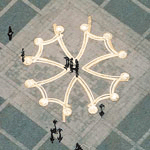
![]() Some
believe the origin of the cross of Toulouse to be pre-Christian.
Its origin may have been a twelve-ray solar wheel, such
as one found in Saint-Michel-de-Lanes not far from Toulouse.
The twelve discs may have symbolised the twelve houses
of the zodiac - as they do in the large modern cross set
into the square outside to Capitole in Toulouse
(shown left). The cross is studded with metal bosses (shown
right) each decorated with examples of the
cross of Toulouse as it developed over the centuries.
Some
believe the origin of the cross of Toulouse to be pre-Christian.
Its origin may have been a twelve-ray solar wheel, such
as one found in Saint-Michel-de-Lanes not far from Toulouse.
The twelve discs may have symbolised the twelve houses
of the zodiac - as they do in the large modern cross set
into the square outside to Capitole in Toulouse
(shown left). The cross is studded with metal bosses (shown
right) each decorated with examples of the
cross of Toulouse as it developed over the centuries.
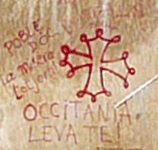
![]()

![]() The
arms of the town of Lloupia (shown right), preserve an ancient
form with the colours reversed. A remote origin of the cross
is possible. For example the Turfan cross, in Eastern Turkestan, closely resembles the arms of Loupia.
This form consists of a single continuous looped line as shown on the left. It is possible that the design travelled into Europe from
the East following the same route that Cathar
teachings did. Similar crosses have been found in northern
Italy (Pisa and Venice), Provence (Forcalquier as well as
Venasque) and Spanish Catalonia (Santa Maria de l'Estany).
The
arms of the town of Lloupia (shown right), preserve an ancient
form with the colours reversed. A remote origin of the cross
is possible. For example the Turfan cross, in Eastern Turkestan, closely resembles the arms of Loupia.
This form consists of a single continuous looped line as shown on the left. It is possible that the design travelled into Europe from
the East following the same route that Cathar
teachings did. Similar crosses have been found in northern
Italy (Pisa and Venice), Provence (Forcalquier as well as
Venasque) and Spanish Catalonia (Santa Maria de l'Estany).
The cross is sometimes referred to as an Occitan Cross and sometimes as a Cathar Cross. It is still a potent symbol throughout most of Occitania. Click on the following link for more on the significance of the Cross of Toulouse.
The Occitan Cross

![]() The Cross of Toulouse still closely associated with the
former territories of the The
Counts of Toulouse, and with its distinctive culture,
including its language, Occitan.
The Cross of Toulouse still closely associated with the
former territories of the The
Counts of Toulouse, and with its distinctive culture,
including its language, Occitan.
The first known written reference to the cross is in a 1173 document written by a Provenšal notary. When the Counts of Toulouse acquired the Provence they added the cross to his arms. It eventually became the symbol of Languedoc resistance to the French invaders following the crusade against the Cathars of the Languedoc in the time of Raymond VI. In the contemporary Song of the Cathar Wars, laisse 109, written in Occitan, it is called la crotz ramondenca (The Raymondine Cross).



![]() The
Cross, or variants of it, is used as a badge of a small
independence movement, those who would like to Occitania
become an independent state, just as Catalans in the Roussillon
and in Spain would like to re-establish an independent Catalonia.
The
Cross, or variants of it, is used as a badge of a small
independence movement, those who would like to Occitania
become an independent state, just as Catalans in the Roussillon
and in Spain would like to re-establish an independent Catalonia.
Similarly it is used by those who would like to see the Occitan language revived.
The Cathar Cross

![]()

![]()

![]() The
Cross of Toulouse is often referred to, especially by those
catering for tourists, as the "Cathar Cross".
The
Cross of Toulouse is often referred to, especially by those
catering for tourists, as the "Cathar Cross".
There is no justification for this. The Cathars detested all representations of the Christian Cross. They regarded it as no more than an instrument of torture - and found worship of an instrument of torture as offensive as modern rationalists do.


![]() The
idea that Cathars might have adopted any form of cross is
unsupported by evidence, and is untenable given their
beliefs. You can be certain that anyone who talks
to you about Cathar Crosses, or tries to sell you one, knows
nothing about the Cross of Toulouse, the Cathars, or the
history of the Languedoc.
The
idea that Cathars might have adopted any form of cross is
unsupported by evidence, and is untenable given their
beliefs. You can be certain that anyone who talks
to you about Cathar Crosses, or tries to sell you one, knows
nothing about the Cross of Toulouse, the Cathars, or the
history of the Languedoc.

![]()

![]() Although
it is mistake to refer to the Toulouse Cross as a "Cathar
Cross", by a coincidence it is in heraldic terms literally
an "empty cross" - an idea that matches Cathar theology
rather well, since the Cathars believed that Jesus was not
crucified.
Although
it is mistake to refer to the Toulouse Cross as a "Cathar
Cross", by a coincidence it is in heraldic terms literally
an "empty cross" - an idea that matches Cathar theology
rather well, since the Cathars believed that Jesus was not
crucified.
RenÚ Nelli, an expert in Catharism, has referred to a different cross - a human-shaped cross schematically represented by a Greek cross topped by an inverted V. You will find this on some monuments to Cathar victims of Catholic Crusaders and Catholic Inquisitors.
![]()

![]() There
is another meaning to the term Cathar Cross. Repentant first
offenders who admitted to having been Cathar heretics, and abjured their faith when
released on licence by the inquisition were required to:
There
is another meaning to the term Cathar Cross. Repentant first
offenders who admitted to having been Cathar heretics, and abjured their faith when
released on licence by the inquisition were required to:
"...carry from now on and forever two yellow crosses on all their clothes, except their shirts, and one arm shall be two palms long while the other transversal arm shall be a palm and a half long and each shall be three digits wide with one to be worn in front on the chest and the other between the shoulders."
Victims were required to renew the crosses if they became torn or destroyed by age. These yellow crosses, like the yellow badges of a different shape that the Catholic Church required Jews to wear, were badges of infamy - warnings to good Catholics to shun the wearers. These crosses were known in Occitan as "las debanadoras" - reels or winding machines. The idea seems to be that offenders could be "reeled in" by the Inquisition at any time. This was a serious concern since a second accusation meant a second conviction, and a second conviction meant death.
Significance of the Cross of Toulouse

![]() The Cross of Toulouse makes an elegant, well proportioned,
yet simple design, and as such has been exploited shamelessly
by the Tourist industry.
The Cross of Toulouse makes an elegant, well proportioned,
yet simple design, and as such has been exploited shamelessly
by the Tourist industry.

![]() Most
people who use the Cross of Toulouse probably never think
about why they use it. But it must be significant
that it is so widely used. In contrast, the
official logo of the Languedoc-Roussillon
is used by virtually no-one other than those sponsored
by the regional council.
Most
people who use the Cross of Toulouse probably never think
about why they use it. But it must be significant
that it is so widely used. In contrast, the
official logo of the Languedoc-Roussillon
is used by virtually no-one other than those sponsored
by the regional council.

![]()

![]() Somewhere, mixed in with the commercial exploitation
at one extreme and frustrated nationalism at the other
is an abiding respect for and identification with the
Counts of Toulouse, so widely loved by
their people and so egregiously treated by their worldly
enemies.
Somewhere, mixed in with the commercial exploitation
at one extreme and frustrated nationalism at the other
is an abiding respect for and identification with the
Counts of Toulouse, so widely loved by
their people and so egregiously treated by their worldly
enemies.
You will find hints of this respect and identification everywhere in the ancient territories of the counts of Toulouse, from the flags flown by pretty much everyone with a flagpole, to the most subtle acknowledgements. The cross of Toulouse features in the middle of the city's arms (shown right), while the mairie of Toulouse and the Midi-Pyrenees region both use the arms undifferenced. The Capitouls of Toulouse surmount the city arms not with a conventional civic mural crown, but with the coronet of their ancient suzerains.
Examples of the Cross of Toulouse





